Ex vivo 100 μm isotropic diffusion MRI-based tractography of connectivity changes in the end-stage R6/2 mouse model of Huntington's disease
- PMID: 37745674
- PMCID: PMC10516267
- DOI: 10.1002/nep3.14
Ex vivo 100 μm isotropic diffusion MRI-based tractography of connectivity changes in the end-stage R6/2 mouse model of Huntington's disease
Abstract
Background: Huntington's disease is a progressive neurodegenerative disorder. Brain atrophy, as measured by volumetric magnetic resonance imaging (MRI), is a downstream consequence of neurodegeneration, but microstructural changes within brain tissue are expected to precede this volumetric decline. The tissue microstructure can be assayed non-invasively using diffusion MRI, which also allows a tractographic analysis of brain connectivity.
Methods: We here used ex vivo diffusion MRI (11.7 T) to measure microstructural changes in different brain regions of end-stage (14 weeks of age) wild type and R6/2 mice (male and female) modeling Huntington's disease. To probe the microstructure of different brain regions, reduce partial volume effects and measure connectivity between different regions, a 100 μm isotropic voxel resolution was acquired.
Results: Although fractional anisotropy did not reveal any difference between wild-type controls and R6/2 mice, mean, axial, and radial diffusivity were increased in female R6/2 mice and decreased in male R6/2 mice. Whole brain streamlines were only reduced in male R6/2 mice, but streamline density was increased. Region-to-region tractography indicated reductions in connectivity between the cortex, hippocampus, and thalamus with the striatum, as well as within the basal ganglia (striatum-globus pallidus-subthalamic nucleus-substantia nigra-thalamus).
Conclusions: Biological sex and left/right hemisphere affected tractographic results, potentially reflecting different stages of disease progression. This proof-of-principle study indicates that diffusion MRI and tractography potentially provide novel biomarkers that connect volumetric changes across different brain regions. In a translation setting, these measurements constitute a novel tool to assess the therapeutic impact of interventions such as neuroprotective agents in transgenic models, as well as patients with Huntington's disease.
Keywords: Huntington’s disease; MRI; connectome; diffusion tensor imaging; mouse; tractography.
Conflict of interest statement
CONFLICTS OF INTEREST Michel Modo is one editorial board member of Neuroprotection, he is therefore excluded from the peer-review process and all editorial decisions related to the publication of this manuscript. Other authors have no personal, financial or institutional interest in the results described in this article.
Figures
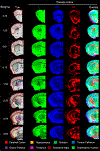
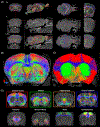
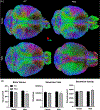
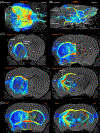
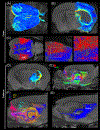
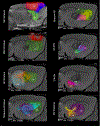
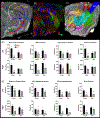
Similar articles
-
Evaluation of early microstructural changes in the R6/1 mouse model of Huntington's disease by ultra-high field diffusion MR imaging.Neurobiol Aging. 2021 Jun;102:32-49. doi: 10.1016/j.neurobiolaging.2021.02.006. Epub 2021 Feb 12. Neurobiol Aging. 2021. PMID: 33765430
-
Selective vulnerability of Rich Club brain regions is an organizational principle of structural connectivity loss in Huntington's disease.Brain. 2015 Nov;138(Pt 11):3327-44. doi: 10.1093/brain/awv259. Epub 2015 Sep 17. Brain. 2015. PMID: 26384928 Free PMC article.
-
Altered CB1 receptor and endocannabinoid levels precede motor symptom onset in a transgenic mouse model of Huntington's disease.Neuroscience. 2009 Sep 29;163(1):456-65. doi: 10.1016/j.neuroscience.2009.06.014. Epub 2009 Jun 10. Neuroscience. 2009. PMID: 19524019
-
Huntington's disease: Brain imaging in Huntington's disease.Prog Mol Biol Transl Sci. 2019;165:321-369. doi: 10.1016/bs.pmbts.2019.04.004. Epub 2019 May 15. Prog Mol Biol Transl Sci. 2019. PMID: 31481169 Review.
-
Diffusion Tensor Imaging in Preclinical and Human Studies of Huntington's Disease: What Have we Learned so Far?Curr Med Imaging Rev. 2019;15(6):521-542. doi: 10.2174/1573405614666181115113400. Curr Med Imaging Rev. 2019. PMID: 32008561 Review.
Cited by
-
Considerations and recommendations from the ISMRM Diffusion Study Group for preclinical diffusion MRI: Part 3-Ex vivo imaging: Data processing, comparisons with microscopy, and tractography.Magn Reson Med. 2025 Jun;93(6):2561-2582. doi: 10.1002/mrm.30424. Epub 2025 Feb 26. Magn Reson Med. 2025. PMID: 40008460 Free PMC article. Review.
References
Grants and funding
LinkOut - more resources
Full Text Sources
